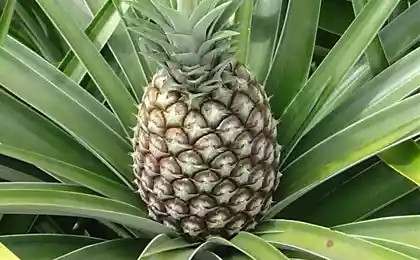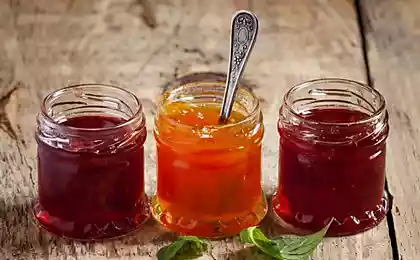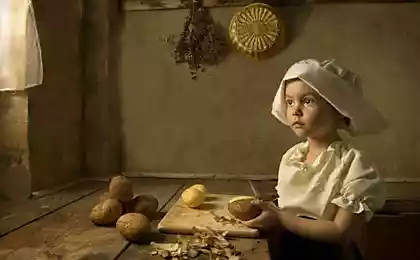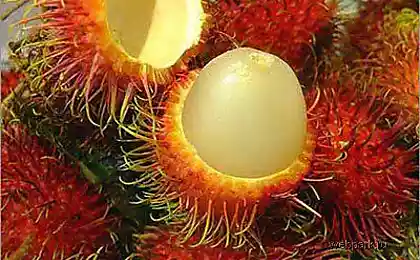2924
25 tropical fruits that you need to try
Countries in Southeast Asia - is a paradise for lovers of tropical fruit. Dragon fruit, mangosteen, tomarillo, durian, snake fruit, and many other exotic names here cease to surprise and become the norm.
Certainly in Russia, in large supermarkets, there are many of these fruits, but, firstly, their prices can differ by an order, and secondly, in order that they appear on the shelves in priglyadnom as their pretty stuffed with chemicals or send immature, which can not affect the taste and useful qualities.
But in Southeast Asia, the home of many of these fruits cost a penny - for example, a ripe and juicy mango season can be purchased for 5 rubles, and large (3 kg), sweet papaya for 30 rubles. As usual apples and pears, here they are, on the contrary, they are among the most expensive fruit. In addition, there is almost no berries, strawberries exception is that we sometimes pleases.
For the sixth month we live in Bali and every day to enjoy a variety of fruit flavors. Tropical fruits are a few dozen, but when you consider that each of them, as a rule, several varieties, and the taste of each variety is unique and unique, it becomes clear how well you live here lovers of fruit

The same fruits to try us in Mexico, India, Sri Lanka, Malaysia and Indonesia are often characterized not only flavors, but also the name and form. Eyes on the market or in the shop and run away, it is difficult to opt for a particular fruit, thus procuring a huge box, barely fit on the bike
About the prices do not consciously write, since all of them are different, depending on the country, seasonality, quality and ability to bargain. In general, most of our tropical fruits less familiar in Peter, even seasonal.
Thus, we begin with the introduction of tropical exoticism.
Snake fruit (snake fruit), Balinese call it calakom
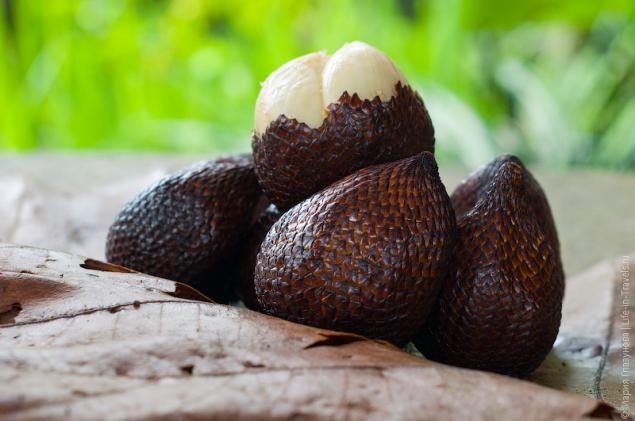
Fruits are round or pear-shaped wedge tapering towards the top, covered with scaly brown skin, snake skin-like, from what happened and the name of the fruit.
The rind is thin and can be easily removed, it is enough to make an incision or torn at the edges and then removed as a shell egg. Pulp is white or beige color consists essentially of three segments. If the fetus is immature, then because of the high content of tannin binds the mouth, it is so we tried it for the first time in Malaysia in the spring - we did not like, and we happily forgot about it.
Here in Bali, Salak, as one of the most common fruits quickly become familiar, we tried it again, and we can say, in love
In Bali, 2 common varieties. One more elongated, consists of 3 identical segments, has a pleasant refreshing sweet taste reminiscent of pineapple and banana with a slight nutty flavor. The second, more rounded, with two large segments, and the third a little pitted, the taste is similar to gooseberries and pineapple. Both varieties are quite interesting, we buy various equally well
Salak contains tannin, which displays the body of harmful substances, astringent, hemostatic and antidiarrheal properties.
In the north of Bali, in the woods, we somehow found a wild Salak. In contrast to the garden, paring his prickly needles in the smaller, no more than 1 mm long, and the fruits smaller size. On the palate they are sweet, but clean because the rough is not very nice, so we fed them to the monkeys, which spikes were not a hindrance and they coped with cleaning as quickly, as do bananas
Tamarillo (tamarillo)
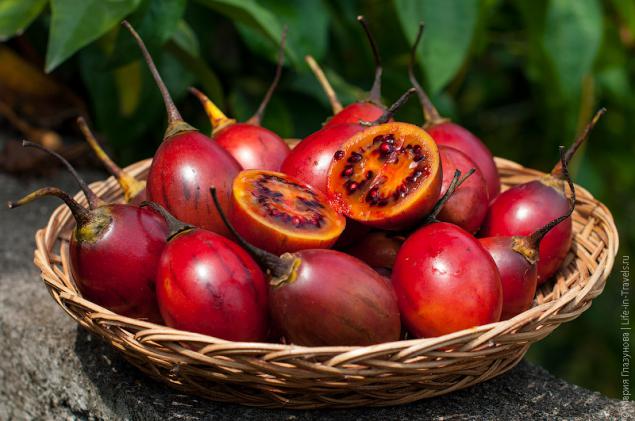
Tamarillo fruits are egg-shaped, about 5 cm long. A brilliant rind is hard and bitter, inedible, and the flesh is sweet and sour, tomato-currant flavor with almost no flavor.
Skin color may be orange-red, yellow, purple or red.
Flesh color is usually golden-pink, thin and round seeds, black edible. The fruits resemble dlinnoplodnye tomatoes, and therefore dubbed it the tree tomato. Tomarillo can be cut into two halves and just squeeze the pulp in the mouth, a clean knife, holding the tail - you will get here is a flower
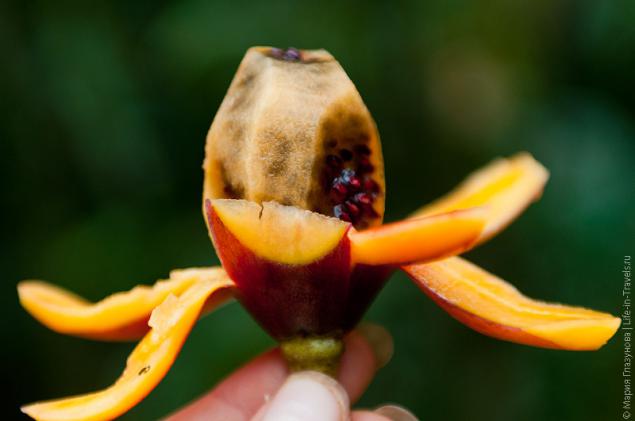
Tamarillo contains large amounts of vitamins A, B6, C and E, and minerals - iron, potassium, magnesium, phosphorus and calcium. Fruit will be useful for those who suffer from migraines.
We loved this fruit because of the berry-currant flavor - Bali fruit is very small, basically all imported (except strawberries).
From tamarillo get a great sauce, adding to it lemon juice, ginger and honey. The sauce is suitable for spicy dishes and desserts.
Mango (mango)
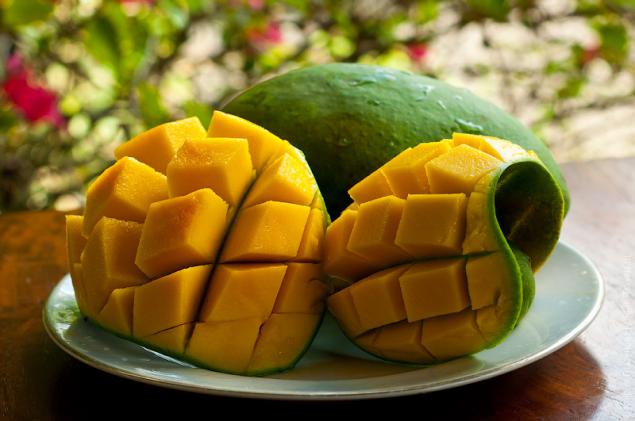
Of the many tropical fruits, mangoes, still remains one of our favorite - it seems you can eat as much as you want and never get bored in St. Petersburg, we sometimes bought them in the store and the concept of different varieties for us there was no - there is simply mango All what was our surprise, that is, of which there are several dozen species.
India collects about 13, 5 million tons of mangoes a year (just think about the figure!) And is thus a major producer (best known variety - mangifera indica 'Alphonso'), the second highest performance China (slightly more than 4 million tons) on the third - Thailand (2, 5 million tons), Indonesia 2 1 million tons.
Mature fruits of different varieties taste very different, they often sweet and has a pleasant aroma of different shades of the honey-ginger even before
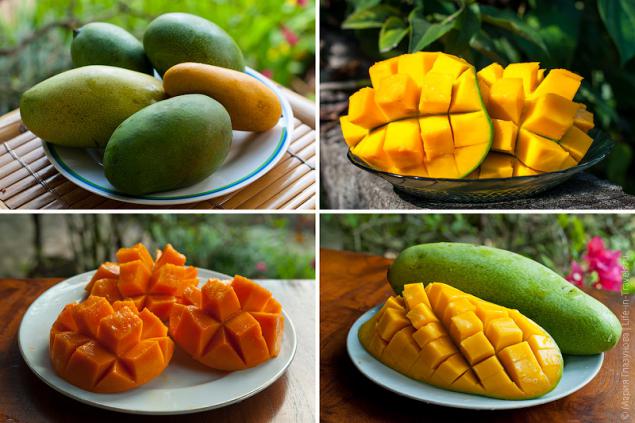
Arriving in India in early November, we were surprised not to find in the sale of mangoes - it turned out that the season starts in April. Fly away to the end of March, and just last week on sale has its first harvest - it was a little red mango, very fragrant and sweet, a few days we could not break away from them.
Very we liked the variety of mango varieties in Malaysia - from Thai pale yellow, with beige flesh inside pachyderms to the green, immature in appearance, but with a bright orange, sweet flesh.
But really, we overeat mangoes in Bali. In May and June, the choice was not very big, but in August, September and especially in October, the diversity of varieties and the prices do not cease to please us. Our favorite brand Harumanis (Harumanis) - green mango with orange, sweet, honeyed flesh.
The mango many vitamins and fructose and little acid. Vitamin A is beneficial to the eyes, it helps in "night blindness" and other eye diseases. Regular consumption of mangoes helps to improve the immune system and protects against infections catarrhal nature. Green mango is rich in vitamin C also
Mangoes are often used in home medicine, for example in Indian Mango used to stop bleeding, for strengthening the heart muscle, as well as improving brain function.
Jackfruit (jackfruit)
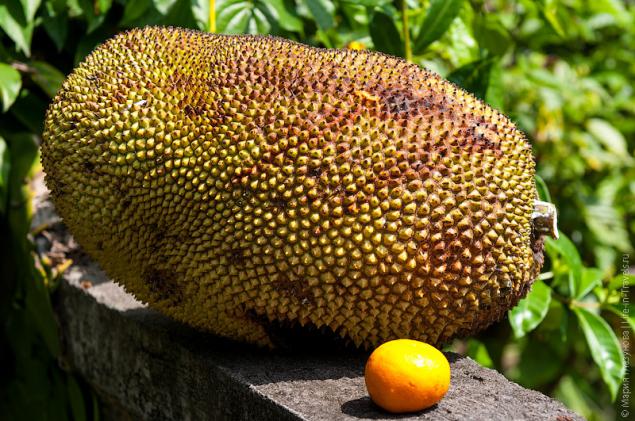
Everyone who first sees jackfruit greatly surprised, and there is nothing - it is the world's largest fruit that grows on a tree. The length of the fruit is 20-90 cm in diameter and 20 cm and weigh up to 35 kg of fruits (see photo comparison near Mandarin).
Thick skin covered with numerous cone-shaped protrusions, spines. Young fruits are green when ripe are yellow-green or brownish-yellow.
If the fruit has fallen, has not matured, it is eaten as a vegetable in India, we have repeatedly tried to curry of jackfruit. But a fresh first tried in Sri Lanka in late April, there just started the season.
Find the mature fruit can be from May to September, when tapped it produces a hollow sound (immature plod- deaf). Inside the fruit is divided into a large proportion of which contain sweet yellow pulp, consisting of juicy slippery fibers. In each lobe located on the elongated seed length 2-4 cm, in one fruit can be up to 500 seeds

The peel and the seeds mature fruit have an unpleasant putrid odor, while the flesh smells nice, have something in common with banana and pineapple, but the taste is still peculiar, for an amateur, we liked very much.
All parts of the plant, including the rind contain latex adhesive, so carve fruit recommended brushing hands with sunflower oil or wearing rubber gloves in the refrigerator fruit can be stored for 1-2 months. In supermarkets and markets jackfruit are sold mainly in the form of the split, as one piece fruit first, scare their spines, and secondly, not everyone is ready to overpower a giant
Because of its severity, jackfruit often falls from the tree and breaks. Because of the strong smell, it can easily seek out the animals, which spread the seeds throughout the forest, which contributes to its active dissemination.
Fruits of jackfruit are very nutritious, they contain about 40% carbohydrates. In particular, therefore, as well as because of the low cost and universal availability, jackfruit in India is called the "bread of the poor", or bread tree. The seeds are also nutritious - they contain 38% carbohydrates, and eat them roasted chestnuts. It tastes a bit dry, but the salads are good.
Dragon fruit Dragon Fruit or (dragon fruit), also known as pitahaya or Pitahaya
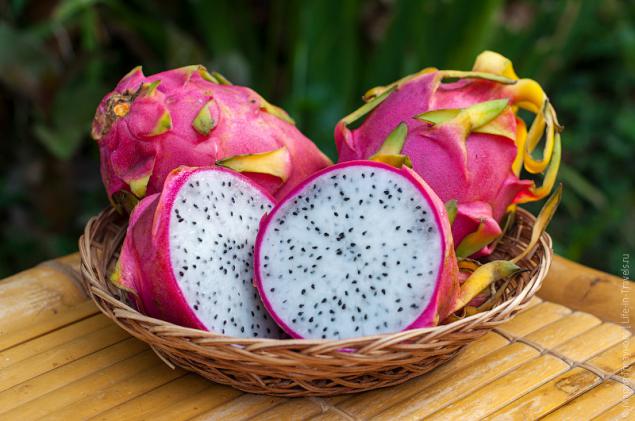
It belongs to the family of "cactus". Because of its interesting and unusual form and bright pink flowers, fruit can not go unnoticed. The fruit has a white or red (depending on variety), creamy flesh and a delicate, slightly perceptible aroma.
The flesh is eaten raw, the taste is sweet. It is convenient to have, cut into 2 halves, scooping the pulp with a spoon. Someone Dragon Fruit can seem bland and not very tasty, but if it follows its rasprobovat, the fruit will certainly enjoy (such as mozzarella, which also does not have a strong expression of taste).
The fruit grows on a cactus blooms only at night. The flowers are also edible, yet they can be brewed into a tea. Fruit nizkokaloriyen, helps with pain in the stomach and has beneficial effects on the quality of vision.
Rambutan (rambutan)
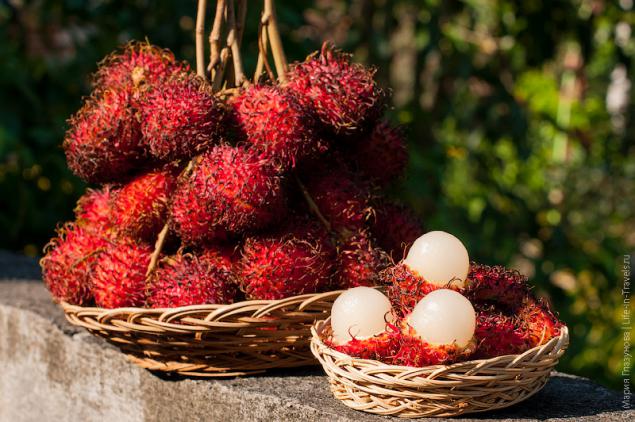
The fruits are round or oval, 3-6 cm in size, grow in clusters of up to 30 pieces, sometimes right on the branch and sell. With the maturation of the fruits change color from green to yellow-orange and then to red. If you want to get the most pleasure, choose the fruit a bright red color.
Juicy fruits are covered with a dense white skinned strewn curved, rigid hairs yellow-brown, 1-2 cm long. The flesh is gelatinous, white, very fragrant and pleasant sweet-sour taste. Inside the inedible seed oval, up to 1, 5 cm. The seeds are poisonous in its raw form, but if they fry, can be eaten.
Seed oil is used in the manufacture of soaps and candles. Rambutan contain carbohydrates, protein, calcium, phosphorus, iron, niacin and vitamin C.
Fruits eat mostly fresh, sometimes canned with sugar. And in Malaysia, the canned fruits are sold on every street corner as a snack, as well as doing slacking drinks.
For the first time we met rambutanami in their homeland - in Malaysia. Malay rambutan translated as "hair-worm".
Fruit is very light in weight, so one kilogram of them may contain a few dozen. By the way, after bananas, which we have settled considerably in India (not just because of the taste, but also for reasons of health safety), number 2 is a fruit that can be easily and safely eat while traveling. Bunch rambutanov can be bought in the market or on the side of the road and immediately eat, what not to do the same papaya or mango, not to mention the fruits that are eaten with the peel.
You just tore the peel in the middle and remove the top half (not spiky hairs), and then send the flesh in his mouth and stay in the hand with the second half rind - even hand washing is not necessary.
In Malaysia, we were just in the season rambutanov (May) and the cost of 1 kg was the same as for 1 kg of mango (about $ 1), but in Bali, they were more expensive than 3 times, however, in October has dropped to $ 1.5 .
Mangosteen (mangostin), also known as mangosteen, mangosteen, Garcinia, mangkut
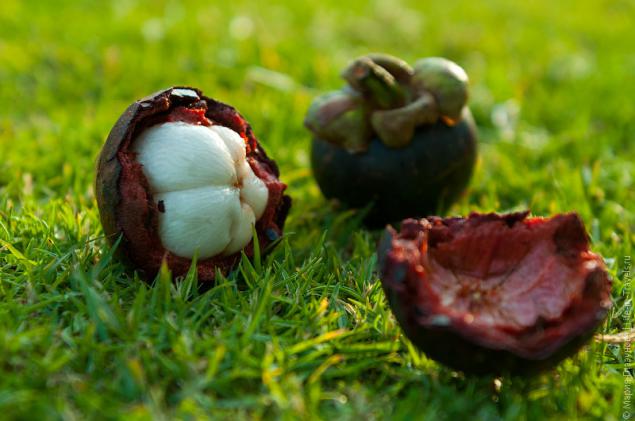
The fruit is round, 4-8 cm in diameter, covered with a thick (1 cm) burgundy-violet inedible skin, under which is 5-8 segments of white, very juicy pulp, with large seeds within each segment.
With the mangosteen we met in Sri Lanka - the first time he saw them, thought that some strange here persimmon))
We were not going to buy them, but the seller at the last moment we kept showing clever trick, opening a second this fruit. Seeing juicy pulp, we could not resist and tried it, well, of course after the bought. The taste of the fruit is very pleasant, creamy sweet and slightly tart.
Mangosteen is recommended to use for the fight against obesity, diabetes, high blood pressure, kidney stones, for colds, depression, and even a huge list of different diseases.
In hot weather, it is an excellent fruit to quench your thirst.
Melody (melodi), also known as pepino, melon pear or sweet cucumber
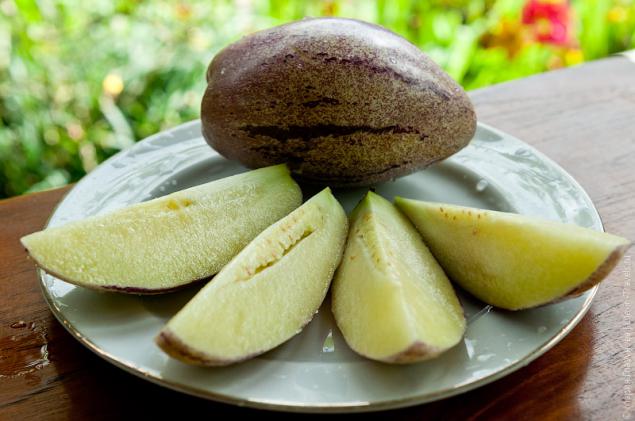
The fruits of various differ in size, shape, color and taste. Some have exotic color - bright yellow, purple, other than resemble eggplants. The pulp of the ripe fruit is light yellow or colorless at all.
The taste reminds Melody mixture of pear and cucumber melon scent. It can be added in sweet desserts and salads (depending on the variety). Here in Bali, we love to add it to salads - fruit is about as well as cucumbers, and the taste sweeter and more interesting.
Flavors, incidentally, is different - from sweet and sour to sweet. Himself Melody is very juicy, it is 92% water, so it is perfect to quench your thirst. Sourness fetus attached to vitamin C, the fruit is also rich in iron, keratin and plenty of vitamins A, B1, B2 and PP.
Longan (longan) or dragon eye
The first name comes from the Vietnamese province of Long An. And secondly, the structure of the fruit - if break "berry" in half, then there is a black stone, which is against the background of transparent beige flesh, reminiscent eyes
Longan grows in clusters on an evergreen tree, which can reach a height of twenty meters. With each tree removed during the summer more than 200 kg of fruit.
Externally, fruits are like peanuts, easy to clean. The color of the fruit inedible outer shell mottled yellowish. Lognan tends to ripen after removal from the tree. Under the skin lies a transparent juicy flesh - sweet and very flavorful with a musky flavor. By pulp is one big bone.
Longan quite rich in vitamins, there are a lot of vitamin C, B1, B2 and B3, and micro and macroelements, such as phosphorus, magnesium, potassium, calcium, copper, iron, zinc, manganese and, in addition, a plurality of Bioacid useful to the skin. With such a wealth of fruit nizkokaloriyen. Longan can be eaten fresh, but you can as a snack with hot and spicy dishes, drink from it quenches thirst and improves appetite
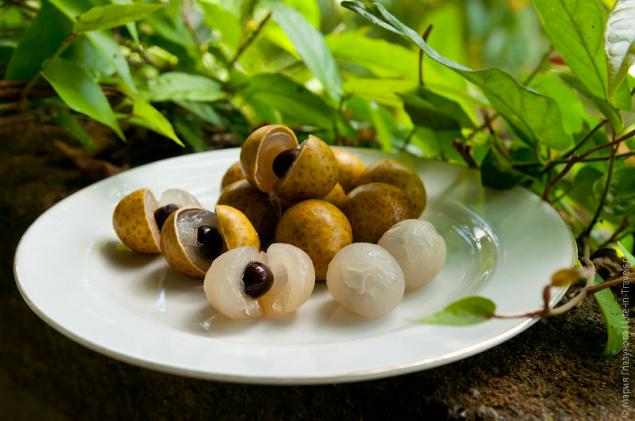
For the first time we tried the fruit in Bali - somehow walking through the market with our Balinese friend Budi, we asked him about his favorite fruit, and he wasted no time, pointed to this rather unremarkable fruit. Budi native to Java and there longan is very popular.
The first time he did not really like us, the fragrance was not as pronounced as expected. We decided that we just did not tasted, and a few days later bought it again - this time longan was very tasty and juicy.
Against the background of other exotic, more delicious-looking fruit, outwardly he certainly loses, but the palette of its constituent mineral components and refreshing taste pushed to buy again and again.
Longan is used in traditional Chinese medicine as a tonic for weakness, fatigue, tachycardia, dizziness, and impaired vision. Also, the pulp of the fruit is used to treat gastrointestinal disorders, reduce body temperature in fever, sedation if causeless excitement, normalization of sleep and improve memory, concentration, attention.
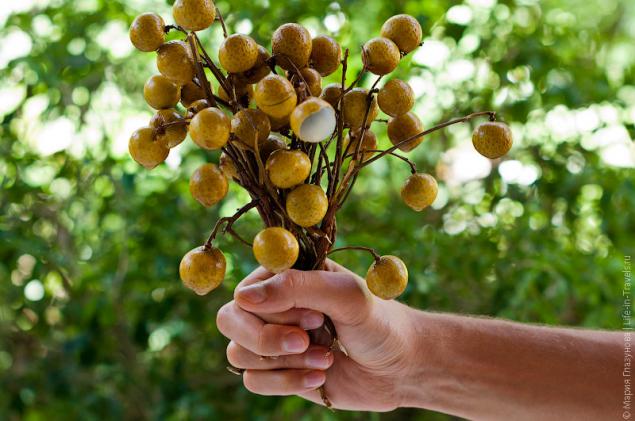
Kepundung (kepundung) or an Asian gooseberry
In appearance very similar to Longan, but the taste is quite different. The rind is firm, but easy to clean. Fruits in white and pink, are viscous jelly structure, there is a bone that trudnootdelima from the pulp - is one of the reasons why kepundung easier to use for the preparation of syrups and sauces, and do not eat fresh.
The taste of the fruit is very pleasant, sweet-sour, refreshing with a light delicate flavor. Kepundung is widely known in Asia source of vitamin C, which makes it useful for treating diseases of the throat and airways.
The fruit is considered sacred among the Indian and Tibetan healers who use dried fruit for a wide range of problems such as diarrhea, fever, liver problems and anemia. Kepundung good for the prevention and treatment of stress, fever, arthritis.
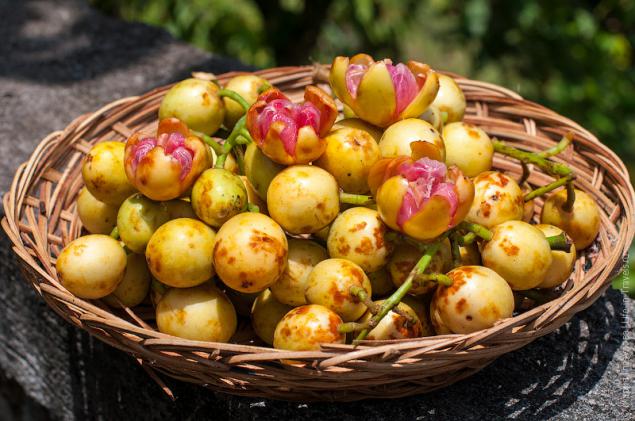
Tamarind (tamarind) or tamarind, he's aces, ASEM, sampalok
Source:
Certainly in Russia, in large supermarkets, there are many of these fruits, but, firstly, their prices can differ by an order, and secondly, in order that they appear on the shelves in priglyadnom as their pretty stuffed with chemicals or send immature, which can not affect the taste and useful qualities.
But in Southeast Asia, the home of many of these fruits cost a penny - for example, a ripe and juicy mango season can be purchased for 5 rubles, and large (3 kg), sweet papaya for 30 rubles. As usual apples and pears, here they are, on the contrary, they are among the most expensive fruit. In addition, there is almost no berries, strawberries exception is that we sometimes pleases.
For the sixth month we live in Bali and every day to enjoy a variety of fruit flavors. Tropical fruits are a few dozen, but when you consider that each of them, as a rule, several varieties, and the taste of each variety is unique and unique, it becomes clear how well you live here lovers of fruit

The same fruits to try us in Mexico, India, Sri Lanka, Malaysia and Indonesia are often characterized not only flavors, but also the name and form. Eyes on the market or in the shop and run away, it is difficult to opt for a particular fruit, thus procuring a huge box, barely fit on the bike
About the prices do not consciously write, since all of them are different, depending on the country, seasonality, quality and ability to bargain. In general, most of our tropical fruits less familiar in Peter, even seasonal.
Thus, we begin with the introduction of tropical exoticism.
Snake fruit (snake fruit), Balinese call it calakom

Fruits are round or pear-shaped wedge tapering towards the top, covered with scaly brown skin, snake skin-like, from what happened and the name of the fruit.
The rind is thin and can be easily removed, it is enough to make an incision or torn at the edges and then removed as a shell egg. Pulp is white or beige color consists essentially of three segments. If the fetus is immature, then because of the high content of tannin binds the mouth, it is so we tried it for the first time in Malaysia in the spring - we did not like, and we happily forgot about it.
Here in Bali, Salak, as one of the most common fruits quickly become familiar, we tried it again, and we can say, in love
In Bali, 2 common varieties. One more elongated, consists of 3 identical segments, has a pleasant refreshing sweet taste reminiscent of pineapple and banana with a slight nutty flavor. The second, more rounded, with two large segments, and the third a little pitted, the taste is similar to gooseberries and pineapple. Both varieties are quite interesting, we buy various equally well
Salak contains tannin, which displays the body of harmful substances, astringent, hemostatic and antidiarrheal properties.
In the north of Bali, in the woods, we somehow found a wild Salak. In contrast to the garden, paring his prickly needles in the smaller, no more than 1 mm long, and the fruits smaller size. On the palate they are sweet, but clean because the rough is not very nice, so we fed them to the monkeys, which spikes were not a hindrance and they coped with cleaning as quickly, as do bananas
Tamarillo (tamarillo)

Tamarillo fruits are egg-shaped, about 5 cm long. A brilliant rind is hard and bitter, inedible, and the flesh is sweet and sour, tomato-currant flavor with almost no flavor.
Skin color may be orange-red, yellow, purple or red.
Flesh color is usually golden-pink, thin and round seeds, black edible. The fruits resemble dlinnoplodnye tomatoes, and therefore dubbed it the tree tomato. Tomarillo can be cut into two halves and just squeeze the pulp in the mouth, a clean knife, holding the tail - you will get here is a flower

Tamarillo contains large amounts of vitamins A, B6, C and E, and minerals - iron, potassium, magnesium, phosphorus and calcium. Fruit will be useful for those who suffer from migraines.
We loved this fruit because of the berry-currant flavor - Bali fruit is very small, basically all imported (except strawberries).
From tamarillo get a great sauce, adding to it lemon juice, ginger and honey. The sauce is suitable for spicy dishes and desserts.
Mango (mango)

Of the many tropical fruits, mangoes, still remains one of our favorite - it seems you can eat as much as you want and never get bored in St. Petersburg, we sometimes bought them in the store and the concept of different varieties for us there was no - there is simply mango All what was our surprise, that is, of which there are several dozen species.
India collects about 13, 5 million tons of mangoes a year (just think about the figure!) And is thus a major producer (best known variety - mangifera indica 'Alphonso'), the second highest performance China (slightly more than 4 million tons) on the third - Thailand (2, 5 million tons), Indonesia 2 1 million tons.
Mature fruits of different varieties taste very different, they often sweet and has a pleasant aroma of different shades of the honey-ginger even before

Arriving in India in early November, we were surprised not to find in the sale of mangoes - it turned out that the season starts in April. Fly away to the end of March, and just last week on sale has its first harvest - it was a little red mango, very fragrant and sweet, a few days we could not break away from them.
Very we liked the variety of mango varieties in Malaysia - from Thai pale yellow, with beige flesh inside pachyderms to the green, immature in appearance, but with a bright orange, sweet flesh.
But really, we overeat mangoes in Bali. In May and June, the choice was not very big, but in August, September and especially in October, the diversity of varieties and the prices do not cease to please us. Our favorite brand Harumanis (Harumanis) - green mango with orange, sweet, honeyed flesh.
The mango many vitamins and fructose and little acid. Vitamin A is beneficial to the eyes, it helps in "night blindness" and other eye diseases. Regular consumption of mangoes helps to improve the immune system and protects against infections catarrhal nature. Green mango is rich in vitamin C also
Mangoes are often used in home medicine, for example in Indian Mango used to stop bleeding, for strengthening the heart muscle, as well as improving brain function.
Jackfruit (jackfruit)

Everyone who first sees jackfruit greatly surprised, and there is nothing - it is the world's largest fruit that grows on a tree. The length of the fruit is 20-90 cm in diameter and 20 cm and weigh up to 35 kg of fruits (see photo comparison near Mandarin).
Thick skin covered with numerous cone-shaped protrusions, spines. Young fruits are green when ripe are yellow-green or brownish-yellow.
If the fruit has fallen, has not matured, it is eaten as a vegetable in India, we have repeatedly tried to curry of jackfruit. But a fresh first tried in Sri Lanka in late April, there just started the season.
Find the mature fruit can be from May to September, when tapped it produces a hollow sound (immature plod- deaf). Inside the fruit is divided into a large proportion of which contain sweet yellow pulp, consisting of juicy slippery fibers. In each lobe located on the elongated seed length 2-4 cm, in one fruit can be up to 500 seeds

The peel and the seeds mature fruit have an unpleasant putrid odor, while the flesh smells nice, have something in common with banana and pineapple, but the taste is still peculiar, for an amateur, we liked very much.
All parts of the plant, including the rind contain latex adhesive, so carve fruit recommended brushing hands with sunflower oil or wearing rubber gloves in the refrigerator fruit can be stored for 1-2 months. In supermarkets and markets jackfruit are sold mainly in the form of the split, as one piece fruit first, scare their spines, and secondly, not everyone is ready to overpower a giant
Because of its severity, jackfruit often falls from the tree and breaks. Because of the strong smell, it can easily seek out the animals, which spread the seeds throughout the forest, which contributes to its active dissemination.
Fruits of jackfruit are very nutritious, they contain about 40% carbohydrates. In particular, therefore, as well as because of the low cost and universal availability, jackfruit in India is called the "bread of the poor", or bread tree. The seeds are also nutritious - they contain 38% carbohydrates, and eat them roasted chestnuts. It tastes a bit dry, but the salads are good.
Dragon fruit Dragon Fruit or (dragon fruit), also known as pitahaya or Pitahaya

It belongs to the family of "cactus". Because of its interesting and unusual form and bright pink flowers, fruit can not go unnoticed. The fruit has a white or red (depending on variety), creamy flesh and a delicate, slightly perceptible aroma.
The flesh is eaten raw, the taste is sweet. It is convenient to have, cut into 2 halves, scooping the pulp with a spoon. Someone Dragon Fruit can seem bland and not very tasty, but if it follows its rasprobovat, the fruit will certainly enjoy (such as mozzarella, which also does not have a strong expression of taste).
The fruit grows on a cactus blooms only at night. The flowers are also edible, yet they can be brewed into a tea. Fruit nizkokaloriyen, helps with pain in the stomach and has beneficial effects on the quality of vision.
Rambutan (rambutan)

The fruits are round or oval, 3-6 cm in size, grow in clusters of up to 30 pieces, sometimes right on the branch and sell. With the maturation of the fruits change color from green to yellow-orange and then to red. If you want to get the most pleasure, choose the fruit a bright red color.
Juicy fruits are covered with a dense white skinned strewn curved, rigid hairs yellow-brown, 1-2 cm long. The flesh is gelatinous, white, very fragrant and pleasant sweet-sour taste. Inside the inedible seed oval, up to 1, 5 cm. The seeds are poisonous in its raw form, but if they fry, can be eaten.
Seed oil is used in the manufacture of soaps and candles. Rambutan contain carbohydrates, protein, calcium, phosphorus, iron, niacin and vitamin C.
Fruits eat mostly fresh, sometimes canned with sugar. And in Malaysia, the canned fruits are sold on every street corner as a snack, as well as doing slacking drinks.
For the first time we met rambutanami in their homeland - in Malaysia. Malay rambutan translated as "hair-worm".
Fruit is very light in weight, so one kilogram of them may contain a few dozen. By the way, after bananas, which we have settled considerably in India (not just because of the taste, but also for reasons of health safety), number 2 is a fruit that can be easily and safely eat while traveling. Bunch rambutanov can be bought in the market or on the side of the road and immediately eat, what not to do the same papaya or mango, not to mention the fruits that are eaten with the peel.
You just tore the peel in the middle and remove the top half (not spiky hairs), and then send the flesh in his mouth and stay in the hand with the second half rind - even hand washing is not necessary.
In Malaysia, we were just in the season rambutanov (May) and the cost of 1 kg was the same as for 1 kg of mango (about $ 1), but in Bali, they were more expensive than 3 times, however, in October has dropped to $ 1.5 .
Mangosteen (mangostin), also known as mangosteen, mangosteen, Garcinia, mangkut

The fruit is round, 4-8 cm in diameter, covered with a thick (1 cm) burgundy-violet inedible skin, under which is 5-8 segments of white, very juicy pulp, with large seeds within each segment.
With the mangosteen we met in Sri Lanka - the first time he saw them, thought that some strange here persimmon))
We were not going to buy them, but the seller at the last moment we kept showing clever trick, opening a second this fruit. Seeing juicy pulp, we could not resist and tried it, well, of course after the bought. The taste of the fruit is very pleasant, creamy sweet and slightly tart.
Mangosteen is recommended to use for the fight against obesity, diabetes, high blood pressure, kidney stones, for colds, depression, and even a huge list of different diseases.
In hot weather, it is an excellent fruit to quench your thirst.
Melody (melodi), also known as pepino, melon pear or sweet cucumber

The fruits of various differ in size, shape, color and taste. Some have exotic color - bright yellow, purple, other than resemble eggplants. The pulp of the ripe fruit is light yellow or colorless at all.
The taste reminds Melody mixture of pear and cucumber melon scent. It can be added in sweet desserts and salads (depending on the variety). Here in Bali, we love to add it to salads - fruit is about as well as cucumbers, and the taste sweeter and more interesting.
Flavors, incidentally, is different - from sweet and sour to sweet. Himself Melody is very juicy, it is 92% water, so it is perfect to quench your thirst. Sourness fetus attached to vitamin C, the fruit is also rich in iron, keratin and plenty of vitamins A, B1, B2 and PP.
Longan (longan) or dragon eye
The first name comes from the Vietnamese province of Long An. And secondly, the structure of the fruit - if break "berry" in half, then there is a black stone, which is against the background of transparent beige flesh, reminiscent eyes
Longan grows in clusters on an evergreen tree, which can reach a height of twenty meters. With each tree removed during the summer more than 200 kg of fruit.
Externally, fruits are like peanuts, easy to clean. The color of the fruit inedible outer shell mottled yellowish. Lognan tends to ripen after removal from the tree. Under the skin lies a transparent juicy flesh - sweet and very flavorful with a musky flavor. By pulp is one big bone.
Longan quite rich in vitamins, there are a lot of vitamin C, B1, B2 and B3, and micro and macroelements, such as phosphorus, magnesium, potassium, calcium, copper, iron, zinc, manganese and, in addition, a plurality of Bioacid useful to the skin. With such a wealth of fruit nizkokaloriyen. Longan can be eaten fresh, but you can as a snack with hot and spicy dishes, drink from it quenches thirst and improves appetite

For the first time we tried the fruit in Bali - somehow walking through the market with our Balinese friend Budi, we asked him about his favorite fruit, and he wasted no time, pointed to this rather unremarkable fruit. Budi native to Java and there longan is very popular.
The first time he did not really like us, the fragrance was not as pronounced as expected. We decided that we just did not tasted, and a few days later bought it again - this time longan was very tasty and juicy.
Against the background of other exotic, more delicious-looking fruit, outwardly he certainly loses, but the palette of its constituent mineral components and refreshing taste pushed to buy again and again.
Longan is used in traditional Chinese medicine as a tonic for weakness, fatigue, tachycardia, dizziness, and impaired vision. Also, the pulp of the fruit is used to treat gastrointestinal disorders, reduce body temperature in fever, sedation if causeless excitement, normalization of sleep and improve memory, concentration, attention.

Kepundung (kepundung) or an Asian gooseberry
In appearance very similar to Longan, but the taste is quite different. The rind is firm, but easy to clean. Fruits in white and pink, are viscous jelly structure, there is a bone that trudnootdelima from the pulp - is one of the reasons why kepundung easier to use for the preparation of syrups and sauces, and do not eat fresh.
The taste of the fruit is very pleasant, sweet-sour, refreshing with a light delicate flavor. Kepundung is widely known in Asia source of vitamin C, which makes it useful for treating diseases of the throat and airways.
The fruit is considered sacred among the Indian and Tibetan healers who use dried fruit for a wide range of problems such as diarrhea, fever, liver problems and anemia. Kepundung good for the prevention and treatment of stress, fever, arthritis.

Tamarind (tamarind) or tamarind, he's aces, ASEM, sampalok
Source:






